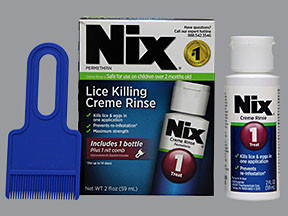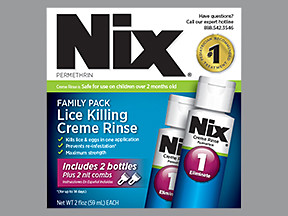PERMETHRIN CREAM RINSE - TOPICAL
PHONETIC PRONUNCIATION: (purr-METH-rin)
COMMON BRAND NAME(S): NIX
GENERIC NAME(S): permethrin
Uses
USES: This medication is used to treat head lice, tiny insects that infest and irritate your scalp. Permethrin is also used to help avoid infestation in people who have close contact with someone who has head lice. It belongs to a class of drugs known as pyrethrins. Permethrin works by paralyzing and killing lice and their eggs (nits).
How to use PERMETHRIN CREAM RINSE - TOPICAL
HOW TO USE: Apply this medication as soon as possible after it is prescribed. When treating head lice, apply this medication to the hair and scalp only. First wash hair with your regular shampoo, but do not use conditioner. Thoroughly rinse the shampoo out with water, and towel-dry hair. Shake this medication well before using. Cover your eyes with a towel while applying this medication. Completely cover the hair and scalp with the medicine (especially behind the ears and on the hairline at the neck). Avoid getting permethrin in your nose, ears, mouth, vagina, or eyes. If the medicine gets in any of these areas, flush with plenty of water. Do not use more medication than prescribed. Leave the medication on your hair for 10 minutes or as directed by your doctor, then rinse with warm water. Towel-dry your hair and comb out any tangles. A single permethrin treatment can help prevent lice from coming back for 14 days. If eyebrows or eyelashes are infested, do not apply this medication to those areas without first consulting your doctor. Head lice lay small white eggs (nits) at the base of hair close to the scalp, especially on the hairline at the back of the neck and behind the ears. After treatment with this medication, the infected person should be checked by another person for lice and nits using a magnifying glass and bright light. To remove nits, use the special comb provided, and follow the instructions on the package. After combing, re-check the entire head every day for nits you might have missed. Remove any nits by combing, by hand using a disposable glove, or by cutting them out. If live lice are seen 7 days or more after treatment, a second treatment with permethrin or another drug may be needed. Inform your doctor if your condition persists or worsens.
Side Effects
Precautions
Interactions
Overdose
Images
Reviews
Disclaimer
IMPORTANT: HOW TO USE THIS INFORMATION: This is a summary and does NOT have all possible information about this product. This information does not assure that this product is safe, effective, or appropriate for you. This information is not individual medical advice and does not substitute for the advice of your health care professional. Always ask your health care professional for complete information about this product and your specific health needs.


No Reviews Yet